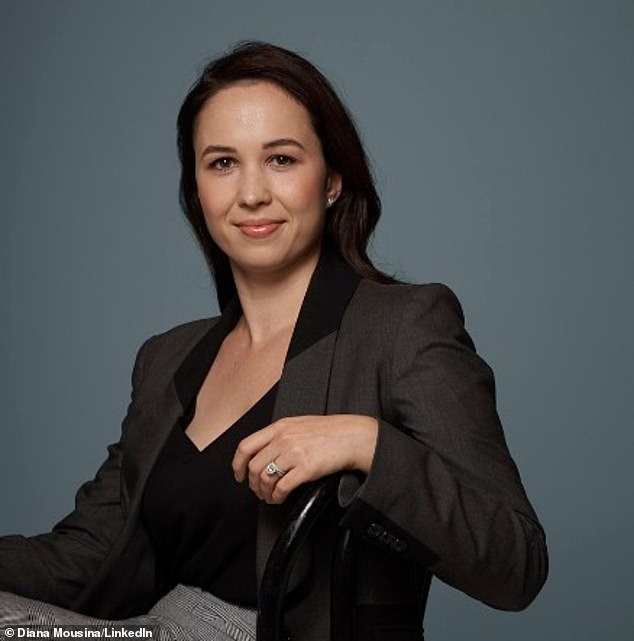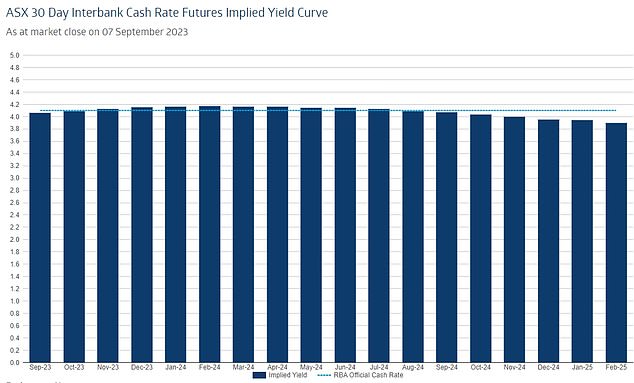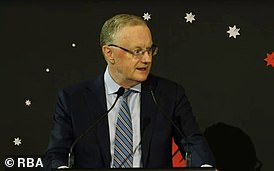Why Aussies should be worried about a SECOND inflation shock – and it would kill off the chance of an interest rate cut as more people work extra jobs to pay bills
A second inflation shock is developing as a real possibility that could deprive Australian home borrowers of a much-needed rate cut next year, one economist fears.
More Australians are already holding two or more jobs to cope with the cost of living crisis, which has led to a surge in rents and mortgage payments.
But the interbank futures market thinks the Reserve Bank of Australia is done with rate hikes, after 12 rate hikes since May 2022 brought cash rates to an 11-year high of 4.1 percent.
The rate-gambling market expects a rate cut by the end of 2024, which would be the first relief from the most aggressive rate hikes since 1989.
A moderation in inflation in the first half of 2023, from the 32-year high at the end of 2022, has convinced financial markets that the worst is over.
But a closer look at monthly inflation data for July showed sharp increases in rents and electricity prices, meaning market forecasts could be premature.
AMP deputy chief economist Diana Mousina said rising prices for some services suggest Australians could be in for a nasty surprise early next year.
A second inflationary shock is becoming a real possibility that could rob Australian home borrowers of a much-needed rate cut next year, one economist fears (pictured shows a shopper from Woolworths in eastern Sydney)
While it appears that the battle against inflation has been won by central banks, some recent leading indicators of inflation have picked up again, suggesting that inflation will pick up again in late 2023/early 2024, which should help financial markets can surprise. ‘ she said.
Another shock to inflation would be bad news for Australians struggling to pay their bills, as new official data shows a seven per cent annual increase in the number of people holding multiple jobs.
The Australian Bureau of Statistics has revealed that 959,000 people still had two jobs in the June quarter.
They make up 6.8 percent of the 14 million people who work.
Women who worked as nurses were most likely to combine two jobs, with 124,100 in this position.
A recent drop in fruit and vegetable prices after a flood-related spike last year could also be reversed, as a return to El Nino weather patterns and drought led to wildfires disrupting harvests and food transportation.
“Extreme weather events can cause disruptions in food production and supply, leading to volatility in food prices,” said Ms Mousina.
“While central banks generally see through price spikes, the events of recent years have shown that temporary price changes can penetrate many components of the supply chain.”
Inflation fell to 4.9 percent in July, the lowest since February 2022, down from 5.4 percent in June, based on the Australian Bureau of Statistics’ monthly benchmark.
The consumer price index has retreated from a 32-year high of 8.4 percent reached in late 2022, with the Reserve Bank expecting inflation to return to the top of its target of two to three percent by mid-2025.
Before Covid, inflation very rarely even exceeded two percent from 2014 to the end of 2019.
In 2021, the economy climbed above the three percent mark for the first time in a decade as global lockdowns exacerbated pressure on the supply chain.
Ms Mousina said inflation is unlikely to return to pre-Covid-19 levels.
“In the medium term, inflation is likely to be higher compared to the low average in the decade before Covid,” she said.
A shift in Chinese supply chains and a related increase in defense spending was expected to keep consumer prices high.
“The reversal of globalization towards onshoring/friendshoring, larger governments and more interventions in sectors, an increase in government defense spending leading to larger budgets, a decrease in the working age population and an increase in of the dependency ratio and the impacts of climate change,” said Ms. Mousina.

AMP deputy chief economist Diana Mousina said rising prices for some services suggest Australians could be in for a nasty surprise early next year

The rate-gambling market expects a rate cut by the end of 2024, which would be the first relief from the most aggressive rate hikes since 1989
Businesses are battling higher interest rates with the ABS on Friday, which also shows sales fell in seven of 13 industries in July, including power, gas and water, and mining, due to lower commodity prices.
Transport and storage, information technology and media, manufacturing, arts and recreational services also shrank.
The Reserve Bank expects the unemployment rate to rise from 3.7 percent in July to 4.5 percent in December 2024 to bring inflation under control.
This would increase the number of unemployed Australians to 654,858 from 523,500 today, meaning a further 131,358 people would lose their jobs.

